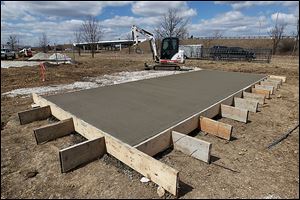
Bowling Green pulls plug on cell-tower plan
City denies Verizon electricity, calls site ‘gross affront’
4/3/2013
The concrete floor for the Verizon cell tower building has been installed east of I-75 near East Wooster Street, but the city of Bowling Green says it will not supply the site with electricity.
BOWLING GREEN — Opponents of a cell tower site at I-75 and East Wooster Street sent a clear message: No power to the tower.
Bowling Green, which operates its own municipal power system, said it will not provide Verizon Wireless with service to a 149-foot cell tower it is building on the interstate’s east side.
City leaders say the Ohio Department of Transportation property detracts from the entrance to the city and Bowling Green State University.
Construction work began this week despite objections and alternative site suggestions from university and city officials. Mayor Richard Edwards called Verizon’s decision to move forward a “gross affront.”
“They haven’t done anything illegal. It’s what I would call bad form and total insensitivity to the community,” he said.
Verizon spokesman Laura Merritt said people use wireless devices “more than ever” and the company needs to keep up with customer demand.
“Ultimately this was the only site that would actually meet the needs and was viable,” she said.
The company made every attempt to consider other sites and considers geographic, equipment, and site requirements when picking a spot, she said.
In 2009, Verizon and ODOT signed a site agreement for use of a 10,000-square-foot tract to install a 149-foot tower and a 12-by-30-foot shelter. The five-year contract calls for Verizon to make annual payments of about $26,280 to ODOT.
Theresa Pollick, a spokesman at ODOT’s Bowling Green district office, said the agreement was made under a previous administration and the department is willing to work with parties to address concerns.
“I don’t want to speculate on the reasoning behind [the contract],” she said. “It’s a contract that we were bound to fulfill.”
City approvals were not required for the tower because it is on state land, Mr. Edwards said. City attorney Michael Marsh told Verizon officials in a letter last month that Bowling Green would not provide electric service to the structure.
Ms. Merritt said the project includes an equipment shelter with a diesel generator, a feature of most of Verizon’s tower sites. She declined to respond to the city’s no-service stance.
“Typically we use those generators as backup in case there’s a power failure,” she said. “I’m not intimating that it’s going to be the sole source of power.”
City and university officials reached out to state Sen. Randy Gardner (R., Bowling Green) in the last six months for help.
Mr. Gardner wanted a face-to-face meeting among the parties to discuss a compromise before construction began, but said that didn’t happen.
“My request all along wasn’t to try to dictate a solution, but to try to bring the parties together to try to find a solution,” he said, adding that he continues to ask Verizon for such a meeting.
Mr. Edwards expressed frustration at what he said was a lack of communication from Verizon, although Ms. Merritt contended that it participated in “a lot of discussion” and attempted to work with the city and university.
BGSU spokesman David Kielmeyer said the university’s chief concern is the aesthetic impact of a tall tower close to the campus entrance. The university is working on creating a master plan for landscape projects, including along Wooster Street.
Verizon’s cost to build similar sites is about $1 million, Ms. Merritt said. She would not provide the specific cost or timeline to complete the Bowling Green site.
Contact Vanessa McCray at: vmccray@theblade.com or 419-724-6065.